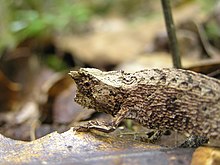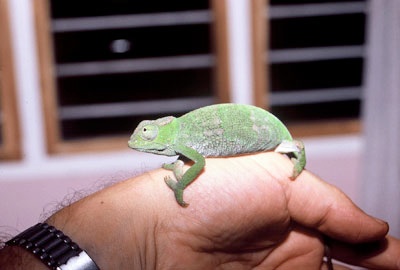Brookesiinae
Rieppeleon brevicaudatus, ♂
The stubby tail chameleons ( Brookesiinae ), sometimes called dwarf chameleons, Erdchamäleons or loggerhead chameleons, are a subfamily of chameleons ( Chamaeleonidae ). Currently their are attributed to about 40 species.
They range in size 23 to 29 mm ( Brookesia micra ) to 16 cm ( Rhampholeon spinosum ), but most animals reach only about 9 cm. Your name You owe their rudimentary trained tail, which usually reaches only a few millimeters in length as opposed to the genuine chameleons ( Chamaeleoninae ). In contrast to the genuine chameleon's camouflage stubby tail chameleons are characterized by unobtrusive colors, mostly dominated by brown and green. Although the animals are also to color changes in the location, but they remain relatively unremarkable because of the small color set. Stubby tail chameleons are unlike true chameleons are not a protected species, it is due to the enormous exports from their home countries, however, already been discussed (as of autumn 2005).
Dissemination
Species of the genus Rhampholeon and Rieppeleon are native to Africa and live there tiny habitats, however, extend almost the entire continent. The animals come in wet and rain forest just to heights of 1000 m. A few species inhabit dry forest or savanna. Brookesia is an endemic species in Madagascar, where the origin of the subfamily is suspected. All types have in common is the habitat that rarely more than 1 m is located above the ground. Many animals spend almost the entire day in the leaf litter.
Propagation
The females lay after a gestation of 25-60 days 1-15 eggs in self-dug caves from. The eggs have depending on a size of 2x1 mm to 17x8 mm. The proliferation of Rieppeleon brevicaudatus regularly achieved in captivity under the right conditions.
Attitude in the terrarium
Stubby tail are chameleons like all chameleons delicate Pfleglinge and are not suitable for beginners animals. Many species require low temperatures, which are often not reached in summer readily due to their montane habitat. There are still frequently Wild caught Rieppeleon brevicaudatus offered commercially, but rarely have a longer life expectancy due to their mostly poor health.
System
In a 2004 published articles Conrad A. Matthee, Colin R. Tilbury and Ted Townsend come after extensive molecular biological analyzes of samples from 83 individuals of the genus Rhampholeon and their comparison to the conclusion that the current classification of Brookesiinae in general and the genus Rhampholeon in special need due to the established relationships of a fundamental revision. The consequences of the investigations by Matthee et. al. can be summarized in three points mainly:
- The species R. brevicaudatus, R. and R. brachyurus kerstenii to be outsourced to the other species of the genus from Rhampholeon basis of morphological and genetic differences and transferred to the new genus Rieppeleon.
- The genus Rhampholeon with the remaining therein species should be further subdivided into the subgenera Rhampholeon, Rhinodigitum and bicuspid.
- The position of the genera Rhampholeon and Rieppeleon within the Chamaeleonidae should be changed, as has proved to be an assignment to the subfamily of Chamaeleoninae in the investigations. As a further consequence, the subfamily of Brookesiinae would include only the genus Brookesia.
The following overview is based on the work of Community chameleons (AG - Chameleons) of the German Society for Herpetology and Herpetoculture published systematics (March 2007 ) or on the taxonomy of the ITIS Standard Report. They both sat at the first two points of the required changes, but remain among the species of the genus Rhampholeon and the new genus to the subfamily Rieppeleon Brookesiinae.
- Genus: Brookesia Gray, 1865 Brookesia ambreensis Raxworthy & Nussbaum, 1995
- Brookesia Antakarana Raxworthy & Nussbaum, 1995
- Brookesia bekolosy Raxworthy & Nussbaum, 1995
- Brookesia betschi Brygoo, Blanc & Domergue, 1974
- Brookesia bonsi Ramanantsoa, 1980
- Brookesia brygooi Raxworthy & Nussbaum, 1995
- Brookesia decaryi Angel, 1939
- Brookesia dentata Mocquard, 1900
- Brookesia exarmata Schimmenti & Jesus, 1996
- Brookesia griveaudi Brygoo, Blanc & Domergue, 1974
- Brookesia karchei Brygoo, Blanc & Domergue, 1970
- Brookesia lambertoni Brygoo & Domergue, 1970
- Brookesia lineata Raxworthy & Nussbaum, 1995
- Brookesia lolontany Raxworthy & Nussbaum, 1995
- Brookesia micra Glaw et al., 2012
- Brookesia nasus Brookesia nasus nasus Boulenger, 1887
- Brookesia nasus pauliani Brygoo, Blanc & Domergue, 1970
- Subgenus: bicuspid Loveridge, 1956 Marshalls Erdchamäleon ( Rhampholeon marshalli Boulenger, 1906)
- Rhampholeon gorongosae Broadley, 1971
- Erdchamäleon ( Rhampholeon spectrum (Buchholz, 1874) )
- Rhampholeon temporalis ( Matschie, 1892)
- Rhampholeon viridis Mariaux & Tilbury, 2006
- Rhampholeon acuminatus Mariaux & Tilbury, 2006
- Rhampholeon beraduccii Mariaux & Tilbury, 2006
- Rhampholeon boulengeri Steindachner, 1911
- Rhampholeon chapmanorum Tilbury, 1992
- Rhampholeon moyeri Menegon, Salvidio & Tilbury, 2002
- Rhampholeon nchisiensis ( Loveridge, 1953)
- Rhampholeon platyceps Rhampholeon platyceps platyceps Günther, 1893
- Rhampholeon platyceps carri ( Loveridge, 1953)
- Rieppeleon brachyurus ( Günther, 1893)
- Rieppeleon brevicaudatus ( Matschie, 1892)
- Rieppeleon kerstenii Rieppeleon kerstenii kerstenii (Peters, 1868)
- Rieppeleon kerstenii robecchii ( Boulenger, 1892)










